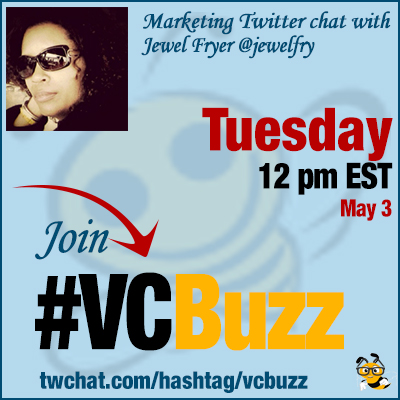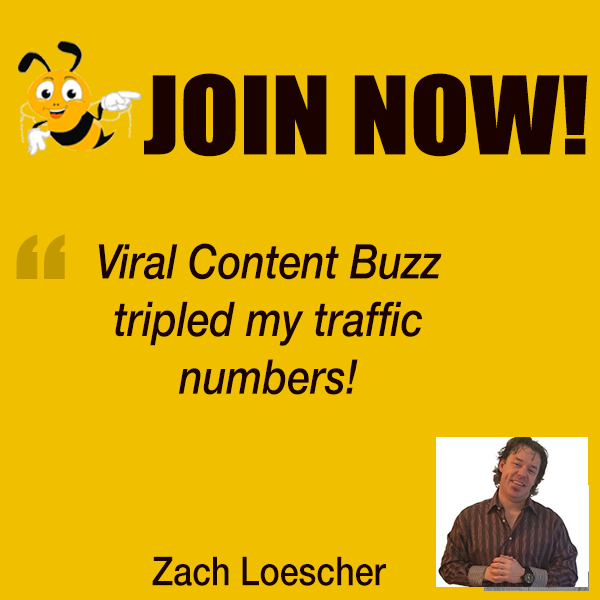 Loyalty building is the most important goal of any marketing campaign: Loyalty and trust bring long-term benefits including steady conversions, repeat customers, organic word-of-mouth marketing, natural exposure, etc.
Loyalty building is the most important goal of any marketing campaign: Loyalty and trust bring long-term benefits including steady conversions, repeat customers, organic word-of-mouth marketing, natural exposure, etc.
***Add #VCBuzz chats to your calendar here.
***Please sign in here to follow the chat -> twchat.com/hashtag/vcbuzz
About Jewel
.@jewelfry is a social media community manager specializing in being the voice for small business owners online to provide good customer service and maintain loyalty.
Connect to Jewel on Linked and Instagram
Questions we discussed
Q1 How did you become a social media community manager? What’s your career path?
I studied Mass Communications and Advertising in college, but I always wanted to use the medium for more than selling. I realized early on that I wasn’t interested in working in a corporate atmosphere so I put marketing to the side for a while.
Once my kids were in school and more self sufficient, I decided I wanted to work but I wanted something flexible. My college education & social media were a perfect fit. I spent a little a year researching & studying online marketing.
I interned with a local media company for a while and then started my own business.
Q2 What does loyalty building involve exactly? How do you describe the process and the benefits to the clients?
Loyalty building means giving your customers a reason to come back again and again. Loyalty building means showing your customers love so they love you back.
Loyalty building means being the first one your customers think of when they think of your product. Loyalty building inspires your customers to bring others to the table.
I believe that great customer service and an above average customer experience is the first step towards loyalty building. It also goes without saying that an excellent product is essential to loyalty building.
As much as possible, give individual, focused attention. In social especially, people want to know that they’re heard.
Listen as much or more than you speak and respond accordingly. Follow up so they know you’re listening and care. Give your customers what they want, not what you think they should have, but also don’t give up on surprising them.
Give back. Share, educate and assist. People don’t think of brands as real friends but they appreciate the same qualities in them as in a good friend.
A2 Give without expecting anything back! Your customers will love you for that! #vcbuzz
— Anna Fox (@manifestcon) May 3, 2016
Q3 How do you measure and / or evaluate loyalty building? How do you report on your work and show positive results?
Every brand has to create their own measurements based on product, style and medium.
A key metric is return customers. Easier to do with web based business, and more complicated in brick and mortar.
Referrals are are harder to measure but useful. Incentives for referrals help give a benchmark and can be useful.
Positive mentions are fairly easy to track and monitor online. Word of mouth is a vital metric that you want to work for, but is often overlooked because it can’t be measured with SM data.
I think that SM people tend to discount word of mouth because we can’t measure it, but it is often the most important.
Q4 What are your favorite social media platforms that work best for loyalty building?
Facebook of course, is a go to for the majority of people and they are always adding features to add in loyalty building.
Twitter is great for customer service & monitoring. You can catch problems & see how people are feeling in order 2 respond.
Instagram is a great place to let your hair down, share and give back in a casual way. I’m more comfortable following and liking content from customers on Instagram as a brand than on other platforms.
A4 Facebook: Ads, Twitter: Monitoring & Customer service, Instagram: Contests and giveaways… #vcbuzz
— Ann Smarty (@seosmarty) May 3, 2016
I think Snapchat stories is a great place for the right brands. It isn’t a good fit for everyone though.
@jewelfry Which niches you think Snapchat is best for? #vcbuzz
— Anna Fox (@manifestcon) May 3, 2016
Snapchat if your target is young and tech savvy. Many SM managers blew Snapchat off in the beginning and that was a mistake. Snapchat is about the experience with a brand, not so much about engagement and that is a learning curve for some.
Pinterest is great because people are very passionate there.
The most important thing is to figure our where your customers are the most comfortable and create a safe place there.
@jewelfry How many social platforms do you recommend customers concentrate on? #vcbuzz
— Sara Duggan (@duggansara) May 3, 2016
Start small, one or two. Then add ones that fit. Don’t try to be everywhere! Quality of quantity. Pinterest is a long game. Things have a longer shelve life there.
Q5 Please recommend some loyalty and community building books and authors!
Tribes: We Need You to Lead Us by Seth Godin is a classic and he is a wealth of good simple advice.
Building Successful online Communities: Evidence-Based Social Design for real examples and case studies.
Also Permission Marketing by Seth Godin again. I’m a big believer in pulling people in instead of forcing yourself upon them.
I would also recommend anything that offers training in group facilitation. Skills used in facilitating physical groups of people are invaluable with online communities.
A5 MyBlogU! Great way to build loyalty through content collaboration! #vcbuzz
— Anna Fox (@manifestcon) May 3, 2016
The best training is probably “as u go” eg Slack (again) #vcbuzz
— Phil Turner (@The5Currencies) May 3, 2016
This is a good introduction to facilitation. Anyone who has had to teach a class, wait on tables, lead a girl scout troop etc, learns facilitation skills, Use them online.
I believe Ann has a Udemy course for building community. Yes, @seosmarty? #vcbuzz
— Don Sturgill (@DonSturgill) May 3, 2016
.@DonSturgill It’s a reputation management course but it helps with community building: https://t.co/NX80mEYlG1 #vcbuzz
— Ann Smarty (@seosmarty) May 3, 2016
I became a certified facilitator for Girls Inc. & had girls circles in schools for years. I use what I learned there every day
Q6 What are your favorite community building tools and how do you use them?
I keep it simple. I think that sometimes we spend more time managing the tool instead of tending directly to our customers. With brands that need multiple managers I prefer Hubspot and Sprout Social.
You can never go wrong with list. I keep them in Evernote, Google Docs and I have a bunch of hidden ones on Twitter.
I still use notebooks to keep myself organized & I constantly take notes about ideas & what I see going on with my communities.
The best tool is TIME. Go down the rabbit holes, follow your fans & their fans. Read everything, get to know them and be useful.
I’m very excited about what Facebook is bringing to messenger. They already have a section to keep notes on followers that is very useful. Facebook groups are like cozy comfortable rooms for friends & people are always more willing to share and reach out there.
Email, mailing list and newsletters are excellent ways of getting to everyone when you don’t abuse them. I think that too many people overuse email and newsletters, so less is more sometimes. You want your email to be a welcome surprise, not something people automatically delete or can’t wait to unsubscribe from.
An old school method that is going out of style but shouldn’t, is handwritten personal notes whenever possible. We get so many emails, messages, and updates. A nice handwritten note in the mail warms the heart and is unexpected.
One of my clients has a business that deals with special occasions and we keep track of birthdays, births, anniversaries etc. The cards we send a year, two years and more with personal notes lets our customers know they are family.
@jewelfry do you automate it with auto-responders (Getresponse)? #vcbuzz
— Anna Fox (@manifestcon) May 3, 2016
I try not to, but sometimes I have to. I have a client in the entertainment business and they get random late night messages all the time. I have an automated message that say’s “It’s late, tell us what’s up and we’ll hit you back when the sun is up.” Auto-responders aren’t bad, use them sparingly.
Our previous community marketing chats:
- Community Management Twitter Chat with @NikkiElizDemere of @InboundOrg #VCBuzz
- Community Building Twitter Chat with @ErikEmanuelli #VCBuzz
- #HOWTO Community Management with Kelly Hungerford @KDHungerford #VCBuzz
- Social Media Customer Service & Community Building #VCBuzz Twitter Chat with @SEOAware
- Learning SEO & Community Building with David Harry @theGypsy #VCBuzz
- Online Event Marketing Twitter Chat with Ivana Taylor @DIYMarketers of @Bizapalooza #VCBuzz


Leave a Reply